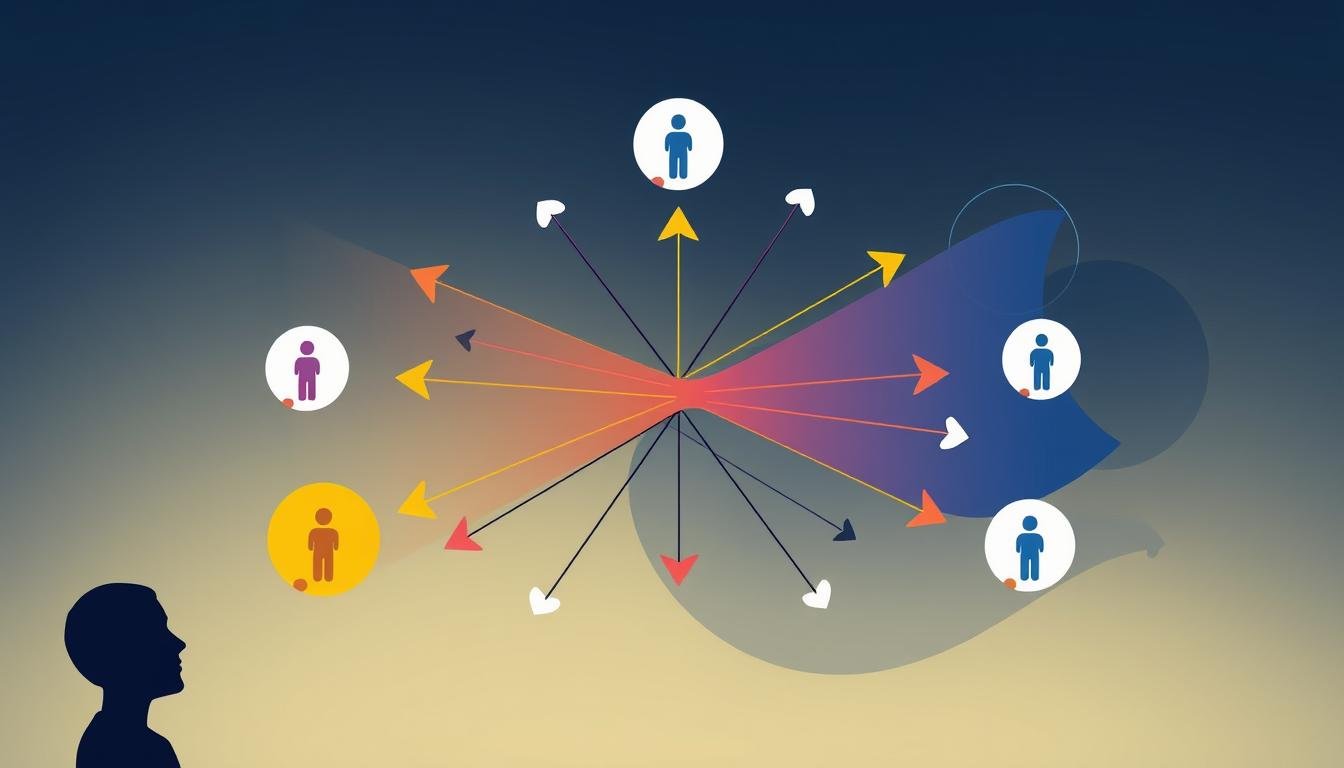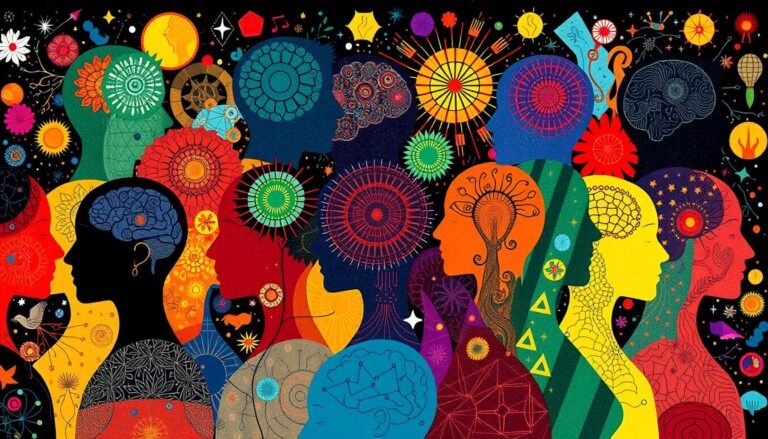Psychological Power Dynamics
Power affects our lives in many ways, often without us realizing it. It shapes how we interact in the office and at home. Knowing about influence strategies and dominance hierarchies can improve our relationships and help us be more assertive.
Recently, studying power has become more popular. Researchers have found interesting facts about how power changes our behavior and choices. For example, feeling powerful makes us happier and more open. But feeling powerless leads to sadness and being more cautious.
Power can also affect how well we connect with others. It can make us more confident in sharing our thoughts but less empathetic. Choosing the right leaders is important for creating a healthy environment, whether at work or in social circles.
Key Takeaways
- Power dynamics influence nearly all social interactions
- Feeling powerful can lead to more positive emotions and goal-oriented behavior
- Powerlessness often results in negative emotions and inhibited actions
- Power can reduce empathy but may increase confidence in sharing opinions
- Understanding power dynamics is crucial for creating balanced relationships
Understanding the Nature of Power in Human Interactions
Power affects our daily lives, shaping how we interact and move through social structures. Studying power dynamics is key for charisma and persuasion. Let’s dive into the role of power in our interactions and its effect on authority.
Defining Power Relationships
Power relationships come in many forms, from obvious to hidden. They impact our personal, work, and political lives. Knowing about power dynamics helps us communicate better and avoid being taken advantage of. Power can come from our skills or our place in organizations.
The Role of Social Hierarchies
Social hierarchies shape power dynamics. They affect who makes decisions, who gets resources, and our chances. History, culture, and institutions create power imbalances. It’s vital to grasp these hierarchies for fairer societies.
Power as a Resource Control Mechanism
Power often means controlling resources. It gives us a sense of control, meeting our needs for freedom and importance. People seek power for achievement, status, and validation. This control can show up in many ways:
- Personal power through knowledge and skills
- Organizational power within company structures
- Societal power influencing economic and political opportunities
| Power Type | Motivation | Impact |
|---|---|---|
| Personal | Achievement, autonomy | Increased self-esteem, independence |
| Organizational | Status, recognition | Decision-making influence, resource control |
| Societal | Stability, conformity | Shaping social norms, influencing opportunities |
Grasping these power dynamics is key for charisma and persuasion. By understanding power in our interactions, we can better handle authority in our lives.
The Science Behind Psychological Power Dynamics
Research shows us the fascinating world of status and dominance. Power lets us influence others, even when they resist. It deeply affects how we interact with each other.
People often don’t realize their own power. This leads to interesting situations in relationships and workplaces.
In social settings, power comes from being needed more than needing others. Personal power comes from how we act and affect others. This difference is key in many situations.
A study of 879 heterosexual couples looked at power and relationship quality. They used the Personal Sense of Power Scale. It showed that feeling powerful can make relationships better, especially in trust and sexual fulfillment.
But, having the same power level doesn’t always mean happiness in a relationship.
In work, power can lead to surprising actions. Those in charge might act impulsively and ignore social rules. Entrepreneurs, for example, need to switch from successful tactics to being authoritative to lead confidently.
“Sovereignty in admitting mistakes can make a person strong. It is advisable to aim for good work quality and confidently acknowledge errors.”
Knowing about these power dynamics helps us deal with complex social situations. It also improves our influence in both personal and work life.
Core Types of Power in Human Relations
Understanding power dynamics is key to mastering assertiveness techniques and charisma development. The Power Dynamics theory by John French and Bertram Raven outlines seven main types of power that shape human interactions.
Coercive and Reward Power
Coercive power uses fear to influence behavior. Leaders might threaten punishment to ensure compliance. On the flip side, reward power offers incentives for desired actions. Both types can significantly impact workplace dynamics and personal relationships.
Expert and Informational Power
Expert power stems from specialized knowledge or skills. People seek advice from those with expertise, making this a potent form of influence. Informational power, though short-term, allows individuals to sway others by controlling access to valuable data.
Referent and Connection Power
Referent power is rooted in personal qualities and values. Leaders with strong character inspire others naturally. Connection power leverages relationships with influential figures, expanding one’s sphere of influence through networks.
Formal and Legitimate Power
Formal power comes from official positions within organizations. It’s often seen as repressive, allowing bosses to manage employees through hierarchical structures. Understanding these power types is crucial for effective persuasion psychology in various settings.
| Power Type | Key Characteristic | Example |
|---|---|---|
| Coercive | Fear-based | Threats of punishment |
| Reward | Incentive-based | Bonuses for performance |
| Expert | Knowledge-based | Sought-after consultant |
| Informational | Data control | Gatekeeper of crucial info |
| Referent | Character-based | Respected community leader |
| Connection | Network-based | Well-connected socialite |
| Formal | Position-based | CEO of a company |
Effects of Power on Human Behavior
Power greatly influences our thoughts, feelings, and actions. It can deeply change how we see things and make decisions. The way we interact with others is shaped by power dynamics.
Cognitive Changes in Power Holders
Getting power changes how we think. We become more confident and focused on our goals. But, this confidence can make us less open to feedback and overlook details.
This can lead to poor decision-making. It’s important to understand these changes in power.
Behavioral Manifestations of Power
Power affects how we treat others. As we gain power, we focus less on others’ needs. This can create a gap between those in power and those who are not.
Influence strategies often use this power imbalance. It’s about how we use power to shape interactions.
Impact on Decision Making
Power greatly influences our decision-making. Those in power often get less feedback and what they do get is biased. This can lead to narrow views and harmful choices.
It’s crucial to understand these dynamics to create fair power structures. This helps in making better decisions.
“Power tends to corrupt, and absolute power corrupts absolutely.” – Lord Acton
Research shows power affects us physically and mentally. It changes our brain function, hormone levels, and stress responses. These changes impact how we see risks and opportunities, shaping our choices and behaviors.
Power Dynamics in Professional Settings
In the workplace, power dynamics shape company culture and impact productivity. It’s important to understand these forces to foster positive interactions and manage conflicts. Power struggles often occur when employees with different types of influence interact.
Studies show concerning trends in professional power dynamics. A Dutch study found power issues affected learning during hospital placements. In Canada, over a third of primary care residents faced harassment due to power dominance by specialists. These findings highlight the need for better management of workplace power structures.
To address these challenges, professionals can use assertiveness techniques and charisma development. These skills help create a balanced work environment where all voices are heard. Persuasion psychology also plays a role in navigating complex power relationships at work.
| Strategy | Benefit |
|---|---|
| Clear boundaries | Minimizes power imbalances |
| Shared goals | Promotes collaboration |
| Open communication | Builds trust and transparency |
By implementing these strategies, organizations can create a more constructive work environment. This approach fosters psychological safety. Research shows it’s crucial for overcoming negative power dynamics, even in strongly hierarchical settings.
The Psychology of Powerlessness and Empowerment
Power dynamics shape our lives in many ways. They affect our personal relationships and work interactions. Knowing about powerlessness and empowerment helps us navigate these dynamics better.
Understanding Powerless Behavior
Powerlessness comes from feeling out of control. The COVID-19 pandemic showed this to many. Feeling powerless can cause anxiety and depression.
It can also make us doubt our ability to change things. In situations where power is uneven, those at the bottom might act submissively or doubt themselves.
Strategies for Personal Empowerment
Empowerment helps us overcome powerlessness. It means taking control of our lives and finding resources that boost our confidence. Key strategies include understanding our emotions and improving how we communicate.
In work settings, empowering staff can lead to better outcomes, especially for vulnerable groups.
Breaking Negative Power Cycles
To change harmful power dynamics, we need to be aware and take action. The first step is to spot unhealthy patterns in how power is used. Building balanced relationships means talking openly and showing respect for each other.
In negotiations about status, it’s important to stand up for what we need while still listening to others.
| Power Dynamic | Impact | Empowerment Strategy |
|---|---|---|
| Financial Control in Relationships | Unequal decision-making power | Establish shared financial goals |
| Workplace Hierarchy | Limited employee autonomy | Encourage open feedback channels |
| Societal Inequalities | Systemic powerlessness | Advocate for policy changes |
By understanding these dynamics and using empowerment strategies, we can escape negative power cycles. This helps us build more balanced and fulfilling relationships in all parts of our lives.
Transforming Destructive Power Dynamics
Power dynamics shape our relationships and society. Recognizing unhealthy patterns is the first step to creating positive change. In Canada, 41% of singles struggle to form lasting relationships, highlighting the need for better influence strategies.
Identifying Unhealthy Power Patterns
Unhealthy power dynamics often stem from misunderstandings. A study found that 57% of Canadians believe their partners inherently understand their love without regular expressions of affection. This assumption can lead to communication breakdowns and power imbalances.
Building Balanced Relationships
Developing assertiveness techniques is key to creating balanced relationships. Self-esteem ranks fourth in Maslow’s Hierarchy of Needs but becomes crucial in negotiations. By focusing on personal growth and charisma development, individuals can foster healthier interactions.
Creating Sustainable Power Structures
Six sources of power exist: physical force, wealth, state action, social norms, ideas, and collective interests. Understanding these can help in building sustainable power structures. Tactics like being comfortable with silence, choosing words carefully, and controlling timing can command respect and maintain power balance.
- Align your needs with others’ goals
- Use strategic silence
- Control conversation timing
- Respond thoughtfully to show confidence
By applying these influence strategies and assertiveness techniques, we can transform destructive power dynamics into positive, balanced relationships that benefit everyone involved.
Developing Healthy Power Relations
Building balanced relationships is key to fostering positive authority dynamics. In the realm of persuasion psychology, understanding how power shapes interactions can lead to more fulfilling connections. Healthy power relations involve a delicate balance of give and take, where both parties feel valued and heard.
Status negotiation plays a crucial role in developing equitable partnerships. It’s not about dominating or submitting, but finding common ground. Research shows that relationships where perceived benefits outweigh costs tend to be more satisfying and long-lasting.
- Establish clear boundaries
- Define shared goals
- Promote openness and honesty
- Seek to understand all perspectives
- Get feedback to improve communication
These strategies can help manage power imbalances in both personal and professional settings. By focusing on mutual respect and understanding, we can create environments where everyone feels empowered to contribute their best.
“Healthy relationships involve a balanced exchange of power and resources, fostering mutual respect and satisfaction without one party dominating the other.”
Remember, healthy power dynamics are not about control, but about creating a space where each person can thrive. By applying these principles, we can build stronger, more resilient relationships that stand the test of time.
Conclusion
Psychological power dynamics shape our world in many ways. They affect our relationships and decisions, whether in business or at home. Knowing how power works helps us navigate and build better connections.
In business, power shows up in who talks and who decides. Personal relationships also have power struggles, like emotional or financial control. Spotting these patterns is the first step to making things better.
To tackle power imbalances, we need skills and strategies. In work, improving negotiation and forming alliances can help. For personal life, setting boundaries and taking care of ourselves is key. Self-reflection and feedback help us see and change power struggles.
Learning to influence and understand power hierarchies makes our environments better. Whether in IT or personal life, being aware is crucial. With knowledge and action, we can turn power struggles into growth and teamwork.
Source Links
- Power play
- What are Power Dynamics?
- Power dynamics and mental health: Neurofuturist discourse of mental health – Emergent Divergence
- Power Dynamics: Nailing Work Power – Freedom to Ascend
- The Psychology of Power: Unveiling the Complexities of Human Influence
- Power dynamics – (Intro to Comparative Literature) – Vocab, Definition, Explanations | Fiveable
- The Psychology of Power & Influence
- How to Manage Negative, Dominant Power Dynamics
- Power balance and relationship quality: Surprising insights from new psychology research
- Power
- The bases of social power: 7 categories to influence power dynamics
- To be powerful, you have to feel powerful: The critical component of Personal Power
- On power and its corrupting effects: the effects of power on human behavior and the limits of accountability systems
- Exploring power dynamics and their impact on intraprofessional learning
- Power dynamics: A systemic inquiry
- ‘Power & Empowerment within a Psychologically Informed Environment’
- What Are Some Examples of Powerlessness?
- Transforming Destructive Thought Patterns into Healthy Dynamics in Relationships – Dating Blog
- Understanding Power Dynamics [With a Practical Approach]
- The Role of Power Dynamics in Relationships: Psychology Insights
- 3 Power Dynamics in Relationships and How to Overcome Them
- Addressing Power Dynamics: A Comprehensive Guide
- Navigating Power Dynamics in IT: The Interplay with Mental Health








